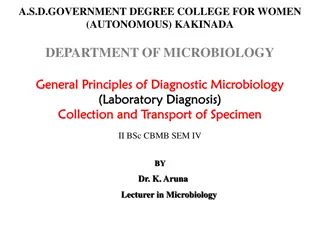Nursing Care for Ventilator-Associated Pneumonia (VAP)
Ventilator-Associated Pneumonia (VAP) is defined as lung parenchyma inflammation occurring 48 hours or more after endotracheal intubation and mechanical ventilation initiation. It is a common nosocomial infection in ICU patients, with significant morbidity and mortality rates. Etiology of VAP involv
2 views • 24 slides
Airway Management in Neurological Patients: ENLS Version 5.0
Explore the essentials of airway, ventilation, and sedation in neurological patients through the ENLS Version 5.0 content. Understand the challenges and goals of managing airways in critical situations such as trauma or respiratory distress. Learn about common indications for intubation and the impo
0 views • 37 slides
Understanding Crash Carts and Their Importance in Medical Emergencies
Crash carts, also known as code carts, are vital in medical settings for providing emergency medical equipment and drugs to resuscitate patients experiencing cardiac arrest. These carts play a crucial role in supporting life-saving protocols and improving efficiency in emergencies, ultimately increa
2 views • 17 slides
Insights on Airway Management in Anesthesia Practices
General anesthesia procedures in the UK NHS involve approximately 2.9 million cases annually, with airway management being a critical aspect. Poor airway assessment and planning, lack of strategies for difficult airways, reluctance to use awake fibreoptic intubation, and inappropriate use of supragl
0 views • 27 slides
Comprehensive Overview of High-Flow Nasal Cannula (HFNC) Systems
High-Flow Nasal Cannula (HFNC) systems, defined as a system providing heated and humidified oxygen at high flow rates, have various applications in healthcare settings including rural hospitals. This presentation covers the definition, indications, contraindications, complications, setup, and use of
0 views • 11 slides
Updates on DAS Guidelines 2015: Key Changes and Recommendations
Revised DAS Guidelines 2015 introduce significant updates for airway management. Changes include rebranding of plan elements, emphasis on oxygenation maintenance, use of videolaryngoscopes, and considerations for various airway scenarios. Specific modifications address techniques such as rapid seque
0 views • 7 slides
Acute Respiratory Failure in ESRD Patients with Diffuse Bilateral Alveolar Infiltrates
In a 45-year-old male with end-stage renal disease (ESRD) and acute hypoxemic respiratory failure, diffuse bilateral alveolar infiltrates with air bronchograms were noted, including right mainstem intubation. Correct positioning and management steps for endotracheal tube placement were discussed. Ad
0 views • 4 slides
Evidence-Based Practice in Critical Care: Focus on FEES in Dysphagia Management
This presentation outlines the activities of the Critical Care and Tracheostomy EBP Network in 2012, including a review of the year, changes in leadership, and discussions on the use of Fiberoptic Endoscopic Evaluation of Swallowing (FEES) in critical care settings. Various research articles are dis
0 views • 16 slides
Collection and Transport of Specimens in Diagnostic Microbiology
Successful laboratory investigations depend on the proper collection and transport of specimens. This involves selecting adequate samples that represent the diseased area, avoiding contamination, obtaining specimens before administering antimicrobials, ensuring biosafety, proper documentation, and t
0 views • 20 slides
AIRWAYS-3 Trial: Advanced Airway Management in In-Hospital Cardiac Arrest
AIRWAYS-3 is a multi-centre, open-label, randomized trial evaluating the clinical and cost effectiveness of a supraglottic airway (SGA) versus tracheal intubation during in-hospital cardiac arrest (IHCA). The trial aims to determine the functional status and health-related quality of life outcomes o
0 views • 9 slides
Awake Intubation Overview and Techniques
Awake intubation, as demonstrated by Dr. Jed Wolpaw MD, M.Ed, is a crucial technique for managing patients with difficult airways or who are at risk of aspiration. This method allows for intubation while the patient is conscious, offering a safe approach in challenging scenarios. The content covers
0 views • 14 slides
Understanding Pandemic Challenges in Arizona: Insights from Dr. Quinn M. Snyder
Explore the challenges faced by healthcare professionals during the pandemic in Arizona through the experiences and insights shared by Dr. Quinn M. Snyder, an Emergency Physician and Director of Analytics. The content delves into topics like early intubation, HCQ usage, mask decontamination, and pat
0 views • 11 slides
Crisis Management in Neonate Workshop 2019 at Niloufer Hospital, Hyderabad
A workshop on Crisis Management in Neonate is scheduled to be held on December 8th, 2019, at Niloufer Hospital, Osmania Medical College, Hyderabad, India. The event aims to enhance knowledge and skills in neonatal venous access, intubation techniques, airway management, and cardiovascular challenges
0 views • 5 slides
Understanding Mechanical Ventilation in COPD Exacerbation
In a case of a 64-year-old woman with COPD exacerbation, managing respiratory distress is crucial. Initiating systemic corticosteroids, doxycycline, and nebulizers while closely monitoring the patient is important. However, in cases where non-invasive ventilation is ineffective, the patient may requ
0 views • 22 slides
Management of Acute Respiratory Distress Syndrome: Case Study and Diagnostics
A 54-year-old woman post-laparotomy presents with respiratory distress and bilateral infiltrates on CXR. The case raises suspicion for Acute Respiratory Distress Syndrome (ARDS). Diagnostic criteria and potential investigations, such as CT pulmonary angiogram, thoracic USS, echocardiogram, bronchosc
0 views • 17 slides
Pediatric Burn Patient Airway Management Overview
Understand the critical aspects of early intubation in pediatric burn patients, including challenges with facial and chest burns, appropriate airway placement strategies, respiratory compromise, and mechanical ventilation strategies for optimal outcomes. Explore a case study of a 4-year-old male wit
0 views • 22 slides















